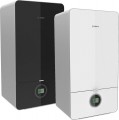Heating area
A very conditional parameter that slightly characterizes the purpose based on the size of the room. And depending on the height of the ceilings, layout, building design and equipment, actual values may differ significantly. However, this item represents the maximum recommended area of the room that the boiler can effectively heat. However, it is worth considering that different buildings have different thermal insulation properties and modern buildings are much “warmer” than 30-year-old and especially 50-year-old houses. Accordingly, this item is more of a reference nature and does not allow us to fully assess the actual heated area. There is a formula by which you can derive the maximum heating area, knowing the useful power of the boiler and the climatic conditions in which it will be used; For more information on this, see "Useful Power". In our case, the heating area is calculated using the formula “boiler power multiplied by 8”, which is approximately equivalent to use in houses that are several decades old.
Condensing
Boilers generate additional heat by condensing water vapour from combustion products. In such units, the combustion gases, before entering the flue, are passed through an additional heat exchanger, in which they are cooled, and the water vapour condenses and transfers thermal energy to the coolant. It allows you to increase the efficiency by 10 – 15% compared to boilers of the classical design — up to the fact that in many similar models, the efficiency exceeds 100% (for more details, see "Efficiency").
The condensation principle of operation is most often found in gas models (see "Power source"); however, solid and liquid fuel boilers with this feature are also produced.
Heat output
It is the maximum useful power of the boiler.
The ability of the device to heat a room of a particular area directly depends on this parameter; by power, you can approximately determine the heating area, if this parameter is not indicated in the specs. The most general rule says that for a dwelling with a ceiling height of 2.5 – 3 m, at least 100 W of heat power is needed to heat 1 m2 of area. There are also more detailed calculation methods that take into account specific factors: the climatic zone, heat gain from the outside, design features of the heating system, etc.; they are described in detail in special sources. Also note that in dual-circuit boilers (see "Type"), part of the heat generated is used to heat water for the hot water supply; this must be taken into account when evaluating the output power.
It is believed that boilers with a power of more than 30 kW must be installed in separate rooms (boiler rooms).
Min. heat output
The minimum heat output at which the heating boiler can operate in constant mode. Operation at minimum power allows you to reduce the number of on-and-off cycles that adversely affect the durability of heating boilers.
Power consumption
The maximum electrical power consumed by the boiler during operation. For non-electric models (see Energy source), this power is usually low, as it is required mainly for control circuits and it can be ignored. Regarding electric boilers, it is worth noting that the power consumption in them is most often somewhat higher than the useful one since part of the energy is inevitably dissipated and not used for heating. Accordingly, the ratio of useful and consumed power can be used to evaluate the efficiency of such a boiler.
Coolant min. T
The minimum operating temperature of the heat medium in the boiler system when operating in heating mode.
Coolant max. T
The maximum operating temperature of the heat medium in the boiler system when operating in heating mode.
Heating circuit max. pressure
The maximum pressure in the heating circuit of the boiler, at which it remains operational, and there is no risk of physical damage to the structure. For a heating system, the maximum pressure is usually about 3 bar, and for a domestic hot water circuit up to 10 bar. When the maximum pressure is exceeded, a safety valve is activated, and part of the water is discharged from the system until a normal pressure level is reached.
DHW min. T
The minimum temperature of domestic hot water (DHW) supplied by a dual-circuit boiler. For comparison, we note that water begins to be perceived as warm, starting from 40 °C, and in centralized hot water supply systems, the temperature of hot water is usually about 60 °C (and should not exceed 75 °C). At the same time, in some boilers, the minimum heating temperature can be only 10 °C or even 5 °C. A similar mode of operation is used to protect pipes from freezing during the cold season: the circulation of water with a positive temperature prevents the formation of ice inside and damage to the circuits.
It is also worth keeping in mind that when heated to a given temperature, the temperature difference ("ΔT") may be different — depending on the initial temperature of the cold water. And the performance of the boiler in the DHW mode directly depends on ΔT; see below for performance details.

